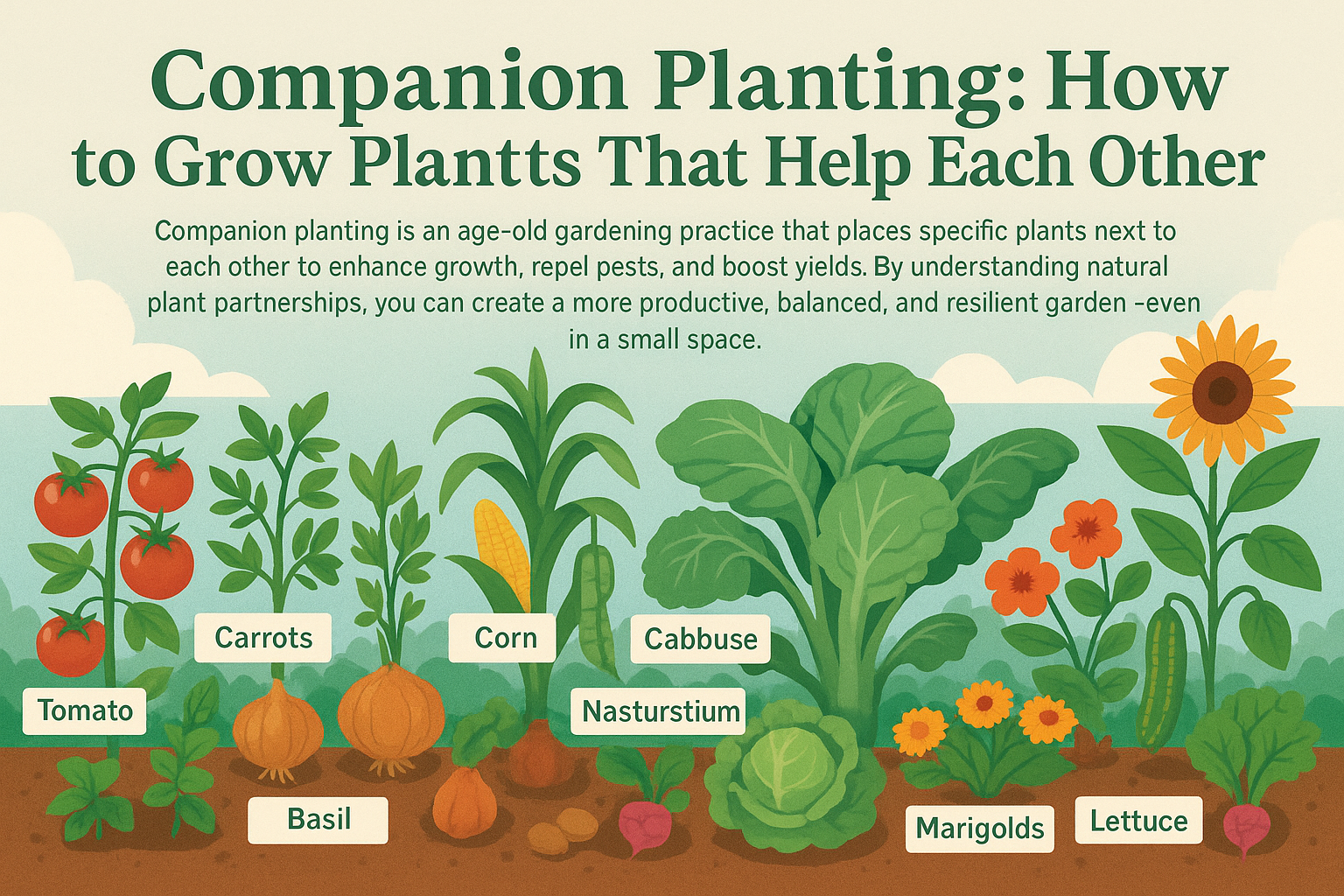Companion planting is an age-old gardening practice that places specific plants next to each other to enhance growth, repel pests, and boost yields. By understanding natural plant partnerships, you can create a more productive, balanced, and resilient garden—even in a small space.
What Is Companion Planting?
It’s the strategic pairing of plants that benefit each other through:
- Pest control
- Pollinator attraction
- Improved flavor or growth
- Soil enhancement
- Space optimization
Think of it as gardening teamwork—plants helping plants.
Benefits of Companion Planting
- Reduce the need for pesticides
- Maximize garden space
- Improve soil fertility
- Create natural shade and support
- Enhance plant health and productivity
It’s one of the most sustainable and beginner-friendly ways to garden smart.
Classic Companion Planting Combos
Here are tried-and-true pairings that work wonders together:
1. Tomatoes + Basil
- Basil repels tomato hornworms and boosts tomato flavor
- Both enjoy sunny spots and similar watering needs
2. Carrots + Onions
- Onions deter carrot flies; carrots protect onions from aphids
- Great for interplanting in garden rows
3. Beans + Corn + Squash (Three Sisters)
- Beans fix nitrogen for corn
- Corn provides support for climbing beans
- Squash shades the soil, reducing weeds
An ancient Native American method that still thrives today.
4. Cabbage + Nasturtiums
- Nasturtiums lure aphids away from cabbage
- Also attract pollinators and add edible flowers
5. Lettuce + Radishes
- Radishes break up soil for tender lettuce roots
- Radishes mature quickly and don’t compete long
6. Cucumbers + Sunflowers
- Sunflowers provide natural trellising for cucumbers
- Their large flowers attract pollinators
7. Peas + Carrots
- Carrots benefit from nitrogen-rich pea roots
- Their growth cycles align for efficient use of space
8. Spinach + Strawberries
- Spinach acts as a living mulch for strawberries
- Helps retain moisture and prevent weeds
9. Marigolds + Almost Anything
- Marigolds repel nematodes and aphids
- Bright flowers attract beneficial insects
- Safe to plant near vegetables, herbs, and flowers
Marigolds are the MVPs of the companion world.
Plants That Should NOT Be Planted Together
Some combinations cause competition or stunt growth:
- Tomatoes + Corn: Compete for nutrients; attract similar pests
- Carrots + Dill: Dill can overpower and inhibit carrot growth
- Cucumbers + Sage: Sage may slow cucumber growth
- Beans + Onions or Garlic: Root secretions may inhibit bean growth
- Fennel + Everything: Fennel can stunt most other plants
Knowing what to avoid is just as important as knowing what to plant together.
Companion Planting in Containers
You don’t need a big garden to use this strategy:
- Pair basil with cherry tomatoes in large pots
- Grow lettuce and radishes in window boxes
- Use herbs like rosemary and thyme as borders for pest control
- Plant marigolds between herb containers for protection and color
Vertical gardens, raised beds, and balconies work great for companion planting.
General Tips for Success
- Use garden plans or diagrams to map plant positions
- Rotate crops each season to prevent disease buildup
- Observe and adapt: watch which plants thrive together
- Combine scents, colors, and textures for diversity
- Don’t overcrowd—give each plant the room it needs
Experimentation is key to finding your best plant pairs.
Final Thoughts: Growing Together, Growing Better
Companion planting brings harmony to your garden by using nature’s own wisdom. When plants work together, your garden becomes more efficient, attractive, and resilient. Whether you’re planting tomatoes and basil or lettuce and radishes, these simple partnerships can turn any space into a green, thriving oasis.

